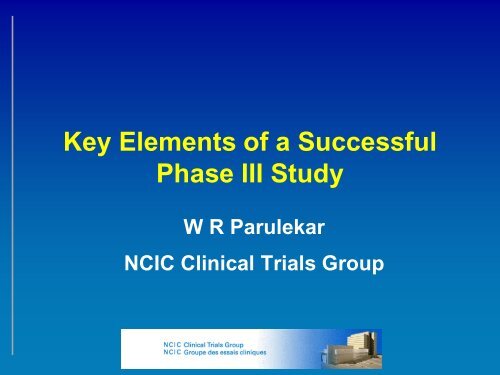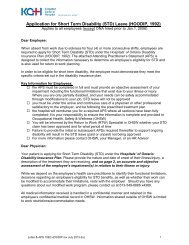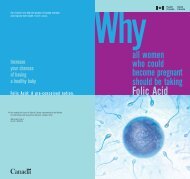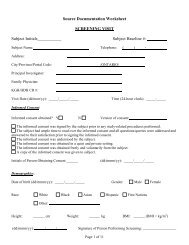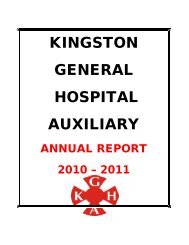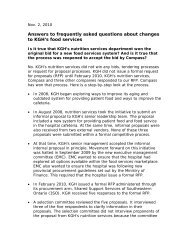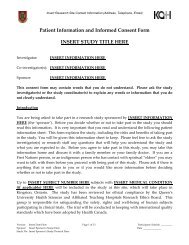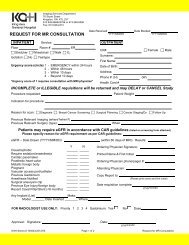Key Elements of a Successful Phase III Study
Key Elements of a Successful Phase III Study
Key Elements of a Successful Phase III Study
Create successful ePaper yourself
Turn your PDF publications into a flip-book with our unique Google optimized e-Paper software.
Components <strong>of</strong> a Clinical <strong>Study</strong>• <strong>Study</strong> concept and design• Protocol document• <strong>Study</strong> conduct• Analysis and manuscript preparation
• Trial question<strong>Study</strong> Concept– Single most important aspect <strong>of</strong> study design– Rationale:• Current therapeutic gap(s), ‘extent <strong>of</strong> theproblem’• Sufficient background and preliminary data• Ability <strong>of</strong> the study to advance the health <strong>of</strong>a population and scientific agenda• Feasible: protocol interventions, accrual,available resources
<strong>Study</strong> Design• A good trial design will be simple, measureimportant clinical parameters, be precise(reduce errors <strong>of</strong> chance), eliminate bias andprovide external validity 1• Simple: design versus logistics <strong>of</strong> conductinga study
<strong>Study</strong> Design• Planned interventions: experimental andcontrol• Masking: Open label or blinded• Method <strong>of</strong> treatment allocation: e.g.minimization; use <strong>of</strong> stratification factors• <strong>Study</strong> population criteria– Disease or health state <strong>of</strong> interest: histology,molecular markers, stage, treatment history– Safety: organ function, other morbidities– Ability to comply with interventions
• Analyses<strong>Study</strong> Design– Outcome measures: Primary and secondary• Unambiguous, accurately measured, clinicallymeaningful: overall survival (or intermediate orsurrogate endpoint) or improvement in quality <strong>of</strong> life ordisease related symptoms.– Intent: test superiority or equivalence or noninferiority– Sample size and final analysis (time to eventanalysis): effect size, Type I and II errorrates, event rate, duration <strong>of</strong> accrual andfollow-up
• Analyses<strong>Study</strong> Design– Interim analyses: how many, when, intent(futility or efficacy), associated statisticaladjustments– Planned subgroup analyses: associatedpower calculations– International guidelines on statisticalprinciples for clinical trials ICHE9(www.ich.org)
<strong>Study</strong> Design• Explanatory (ideal setting) versus pragmatic(real world) studies 2,3– Subtle differences in today’s researchenvironment– Many shared characteristics– Terminology relates to interpretation andapplication <strong>of</strong> trial results rather than aspecific characteristic in either study design
EligibilityExplanatory• Selected population e.g. Centralreview <strong>of</strong> histology or biomarkerPragmatic• Broad criteriaInterventions• Highly prescribed interventions• Centralized review <strong>of</strong> entrycriteria, outcome measurements• Rigorous monitoring• Less rigidguidelines fortreatmentdelivery andoutcomeassessmentOutcomeAnalysisMay emphasize biological activity(i.e. PFS or clinical benefit) inaddition to clinically meaningfuloutcome measuresUse <strong>of</strong> censoring and sensitivityanalyses to isolate, estimate theefficacy <strong>of</strong> a particular therapyClinicallymeaningful – livelonger or better
Protocol Document• Provides quality control– Specifies overall research plan– Provides guidance for management <strong>of</strong> theindividual study subject– Basis for publications• Legal / ethical properties: Regulators, EthicsBoards• Thus it must be a structured and accessibledocument
<strong>Study</strong> Protocol• Non adherence to a protocol: design versusbiological validity– Rigid adherence to a protocol (designvalidity) does not guarantee clinicallyrelevant data
Generic Protocol
Protocol Content• <strong>Study</strong> schema• Background and rationale• Objectives• Patient population• Trial design• Treatment• Trial procedures
Protocol Content• Endpoint and evaluation criteria• Statistical considerations• Correlative studies• Serious adverse event reporting• Data collection• Administrative issues• Informed consent• Appendices
• Spirit Initiative 4Protocol Content– International collaborative effort launched in2007– Standard Protocol Items: Recommendations forInterventional Trials– Aims to improve the quality <strong>of</strong> trial protocols byproducing evidence-based recommendations fora minimum set <strong>of</strong> standard items that protocolsshould address– Soon to be published Statement, 33 ItemChecklist and Explanation and Elaborationdocument.
<strong>Study</strong> Conduct• <strong>Study</strong> conduct is dynamic and requiresmultiple levels <strong>of</strong> oversight to ensure that thesafety, ethical and scientific standards aremet.• Amendments to the protocol are part <strong>of</strong> trialconduct and should not be viewed asindicators <strong>of</strong> a flawed study
<strong>Study</strong> Conduct• Attentive to internal data– Adverse and serious adverse event data,laboratory data– Adherence to protocol therapy and interventions– Accrual– Event rate• Attentive to external data– Safety– Efficacy - validity <strong>of</strong> statistical assumptions,continued relevance <strong>of</strong> the ongoing study
<strong>Study</strong> Conduct• Transparent and collaborative– Mandatory oversight <strong>of</strong> independent DataSafety Monitoring Committee– Interactive / informative with studyparticipants, ethics boards, scientificcommunity, funders• Compliant with ethical/ regulatory / scientificstandards
Analysis• The analysis preparation begins at theconcept development stage and the processcontinues until the publication <strong>of</strong> results• Fidelity with the protocol• Database compilation: transparent andconsistent processes <strong>of</strong> data management• Analysis plans and details prospectivelydefined in the statistical analysis plan
Publication• Manuscript requirements– Uniform requirements for manuscriptssubmitted to biomedical journals (ICMJE):Writing and editing for biomedicalpublications (www.icjme.org)• Ethical considerations (including authorshipand contributorship, COI, privacy…)• Publishing and editorial issues (includingobligations to publish negative studies,registration <strong>of</strong> studies…)• Manuscript preparation and submission
Web Resources: Regulatory• E6. ICH Guideline on Good Clinical Practice– http://www.hc-sc.gc.ca/dhpmps/prodpharma/applic-demande/guideld/ich/efficac/e6-eng.php– Force <strong>of</strong> law (2001); research conductedunder Clinical Trials Application (CTA) withHealth Canada (HC)• Division 5 <strong>of</strong> the Food and Drug Regulations– http://www.hc-sc.gc.ca/dhp-mps/compliconform/clini-pract-prat/reg/1024-eng.php– Trials conducted under a CTA with HC
Web Resources: Regulatory• Guidance 0068 - Guidance for RecordsRelated to Clinical Trials– http://www.hc-sc.gc.ca/dhp-mps/compliconform/clini-pract-prat/docs/gui_68_tc-tmeng.php– Describes record retention requirements fortrials conducted under a CTA with HC• Guidance for Clinical Trial Sponsors– http://www.hc-sc.gc.ca/dhpmps/prodpharma/applic-demande/guideld/clini/ctdcta_ctddec-eng.php– HC requirements and regulations
Web Resources: Regulatory• OHRP website - Policy and Guidancewebpage– http://www.hhs.gov/ohrp/policy/index.html– Includes information related to trials receivingUS federal funds• Clinical Trials Registries– http://www.ClinicalTrials.gov– http://www.who.int/ictrp/en
Web Resources: Ethics• Tri-Council Policy Statement Version 2– http://www.hc-sc.gc.ca/index-eng.php– Not formally adopted by HC; basis <strong>of</strong> ethicalprinciples in most academic institutions• Declaration <strong>of</strong> Helsinki from the World MedicalAssociation– http://www.wma.net/en/30publications/10policies/b3/• Belmont Report– http://ohsr.od.nih.gov/guidelines/belmont.html
Web Resources: Protocol Content• TNM Staging Criteria– www.cancerstaging.org• Response Criteria– RECIST 1.1 5– http://ctep.cancer.gov/protocolDevelopment• Toxicity Criteria– Common Terminology Criteria for AdverseEvents (CTCAE)– http://ctep.cancer.gov/forms
References1. Piantadosi S. Clinical Trials: A Methodologic Perspective.New York NY: John Wiley & Sons; 19972. Meyer RM. Generalizing the results <strong>of</strong> cancer clinicaltrials. J Clin Oncol. 2010;28:187-1893. Meyer RM. Contrasting Explanatory and PragmaticRandomized Controlled Trials In Oncology. ASCO 2011Educational Book 72-75.4. Strengthening the Credibility <strong>of</strong> Clinical Research.Lancet, 2010; 375: 12255. Eisenhauer EA, Therasse P, Bogaerts J et al. Newresponse evaluation criteria in solid tumours: revisedRECIST guideline (version 1.1). Eur J Cancer.2009;45(2):228-47
Learning ObjectivesAt the end <strong>of</strong> the session, the participants shouldbe able to: List the characteristics <strong>of</strong> a phase <strong>III</strong> study Understand the components <strong>of</strong> a phase <strong>III</strong>study List and understand the multiple roles <strong>of</strong> thestudy protocol and describe its generalcontent List useful web resources that relate to clinicaltrial design, conduct and reporting


